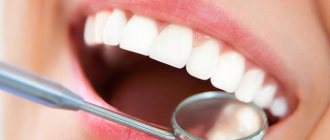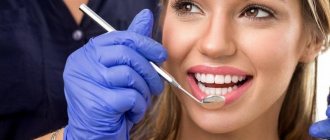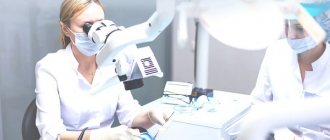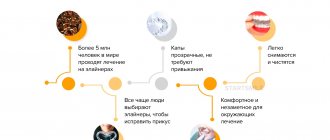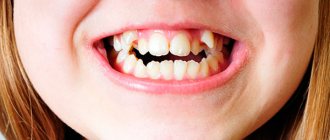- Signs of correct bite
- Types of malocclusion
- Why do you need to correct your bite?
- Until what age can a bite be corrected?
- Ways to correct a bite
- Aligners
- Trainers
- Veneers
- Bracket system
- Types of braces
- Which braces system should you choose?
- How long does it take to correct a bite?
- How to care for braces?
Malocclusion occurs in almost 80% of the Russian population. In a third of cases it requires orthodontic treatment. And it’s not just a matter of aesthetics - if you are often bothered by headaches, earaches and dizziness, then perhaps it’s a malocclusion. An orthodontist deals with the correction and prevention of malocclusions.
The most common misconception about bite is related to age. Many people think that it can only be corrected in childhood, but today, with the advent of new technologies, this can be done at any age.
In this article we will look at the causes and types of malocclusion and why it needs to be corrected. We will also tell you about treatment methods and dispel the most common fears. Orthodontist Olesya Milagina comments on current issues of orthodontic treatment for us.
What are malocclusions?
Types of bites
There are several malocclusions, depending on the position of the teeth relative to each other:
- Diastema. A small gap between the front incisors of the upper jaw. It is common in children, but usually goes away by adulthood. But for some, the diastema does not disappear even after the final change of bite, and as a result remains with the person for life.
- Tremes. Small spaces between all other teeth. Also common in children, but sometimes do not go away by adulthood.
- Crowding. With this anomaly, the teeth creep on top of each other due to the fact that there is not enough space for them in the jaw. Often, crowding appears late, when a person begins to erupt in numbers of eights - they press and squeeze the remaining teeth in the row.
- Transposition or dystopia. Teeth erupting in atypical places - above or below the dentition, or even on the palate. This anomaly occurs if there is too little space in the dentition, or if the rudiments of the teeth are not formed correctly. Sometimes supernumerary teeth, that is, extra teeth caused by genetic abnormalities, become dystopic.
- Distal bite. Reduction in the size of the lower jaw, due to which the lower teeth are located far behind the back ones, and the upper ones often protrude forward. This pathology is especially widespread among Europeans and Russians.
- Mesial bite. In this case, the situation is reversed - the upper teeth are hidden behind the lower teeth. This is often accompanied by crowding in the upper jaw, and on the contrary, tremors appear in the lower jaw.
- Open bite. A situation where the teeth do not close together and a gap forms between them. An open bite can occur on both the front and back teeth. It is rare, mainly due to unfortunate heredity, mouth breathing or thumb sucking.
- Deep bite. The upper teeth overlap the lower teeth too much, sometimes even resting on the mucous membrane of the lower jaw.
- Crossbite. The teeth do not close normally, but cross each other, randomly overlapping each other.
These pathologies can exist either separately or together. Sometimes they are practically invisible, and a person may not even know that the bite is broken, although in fact the anomaly exists and requires treatment.
Pros and cons of braces
The system has many advantages. The main ones:
- Quickly fix the problem. To achieve the desired effect, long-term treatment is not necessary; the dental units take the correct position in a short period of time. This especially applies to structures made of metal.
- Many indications when the use of staples is applicable. These include both minor deviations and severe malocclusions that do not require surgical intervention.
- Possibility to combine with other therapeutic methods. Correction is applied individually or in combination, it all depends on the individual characteristics of the patient and the severity of the pathological process.
Flaws:
- External systems are visible to the naked eye. Even if you choose the most aesthetic options, they will still be noticeable to others. However, nowadays, orthodontic appliances have become a fashionable accessory, which indicates that the owner cares about his health. There are also lingual braces, hidden and unnoticeable.
- More careful oral hygiene is required. If you do not devote enough time to care, plaque will begin to accumulate and tartar will form. Professional cleaning in a dental office is recommended at least 3 times a year.
- Possibility of injury to mucous membranes (tongue, inner cheeks, gums). In the first time after installation, this phenomenon is not uncommon. But patients get used to the discomfort. In addition, you can purchase special wax to seal traumatic elements.
- Diet restrictions. This diet involves avoiding hard, viscous and sticky foods. Otherwise, the structure will quickly become unusable, and the duration of therapy will increase significantly.
Causes of malocclusions
Types of malocclusion
There are many causes of malocclusion. They can be divided by age groups.
In childhood, the bite is disrupted for the following reasons:
- Various genetic abnormalities.
- Unlucky heredity - the parents have an incorrect bite, or the child received too small a jaw from his mother and too large teeth from his father.
- The child’s habit of breathing with his mouth open, sucking fingers or a pacifier after teething.
- Early loss of baby teeth due to caries or their removal instead of treatment.
- Incorrect attachment of the frenulum of the tongue or lips, creating pressure on the teeth.
If these negative factors were not present in childhood, then by adulthood a person’s bite usually remains normal. However, it may fail for the following reasons:
- Jaw injuries, especially those accompanied by tooth loss.
- Extraction or loss of teeth - adjacent teeth will move to take up the vacant space.
- Inflammation of the gums, accompanied by loss of bone tissue - teeth become loose and shift.
- Eruption of wisdom teeth, especially if there is no room for them in the jaw.
In this case, the bite can deteriorate at 20, 30 and even 40 years of age.
Why is it necessary to correct your bite?
If a malocclusion bothers a person from an aesthetic point of view, he will, of course, want to correct it. But there are people who do not care about their crooked teeth, and it seems that in this case it is not worth starting orthodontic treatment. But in fact, an incorrect bite can cause other problems besides aesthetic ones.
Due to the fact that the teeth are positioned incorrectly, the chewing load is abnormally distributed between them. As a result, some teeth wear down, while others are less involved in chewing, which is why the bone tissue underneath them atrophies. This leads to frequent caries, sensitivity and loose teeth. In addition, protruding teeth can injure the cheeks, gums and tongue, causing various inflammations to appear in the mouth.
With an incorrect bite, not only the teeth are incorrectly positioned, but also the jaws themselves. Because of this, the functioning of the temporomandibular joint is disrupted. This leads to problems opening the mouth, clicking of the jaw, and sometimes even severe pain.
Among other things, malocclusion can cause two more serious global problems:
- Gastrointestinal diseases. Sometimes people with uneven teeth find it difficult to chew food thoroughly. As a result, it enters the stomach insufficiently crushed, causing frequent disorders and other problems.
- Headache. Due to improper jaw alignment, people with bad teeth often suffer from migraines and pain for no apparent reason.
Well, the last but not least important problem is that an incorrect bite interferes with prosthetics. When one or more teeth are lost due to malocclusion, it is often difficult to place a bridge, crown or implant - the neighboring teeth get in the way. And since almost everyone has to get dentures as they age, an incorrect bite can make this process much more difficult, so it’s best to take care of correcting it in advance.
Braces severely injure mucous membranes
It is believed that orthodontic structures strongly rub the inner surface of the lips and cheeks, injure the tongue, and get in the way in the mouth. In fact, discomfort can only occur during the adaptation period. Orthodontic structures have an ergonomic shape; all their elements are rounded and do not have sharp corners to prevent injury to the mucous membranes. With high sensitivity, if discomfort still occurs, you can use special wax to cover the protruding parts of the structure.
Diagnosis of malocclusions
Sometimes malocclusions are completely obvious to the patient - for example, it is easy to notice a diastema or serious problems such as crowding or crossbite. But sometimes the anomalies are minor and are hidden in the area of the chewing teeth. In this case, a person can live and not even know that his bite is incorrect.
Such defects are not noticeable, even to others, but are no less harmful to health than noticeable ones. Since it is impossible to recognize them on your own, it is better in this case to consult a doctor.
Usually, even a dentist can recognize such minor bite defects during a routine examination or during caries treatment. In this case, he informs the patient, describes the defect in the medical record and prescribes treatment with an orthodontist.
Sometimes malocclusions are difficult to recognize, so if the therapist finds nothing, it makes sense to visit an orthodontic specialist once, just in case, so that he can conduct a thorough examination and accurately determine whether you have problems with your bite. For diagnosis, visual examination, x-rays and computed tomography are used.
The bite can change throughout life, so it is important to visit a doctor every six months to a year. At preventive appointments, the dentist carries out cleaning, diagnoses caries and can immediately notice the slightest changes in the bite, which will be very easy to correct at the initial stage.
Why you need to straighten your teeth
Please note that the question is not whether it is worth correcting the bite - it simply needs to be done, and for several reasons:
- To avoid increased abrasion, caries, removal - when everything is normal, all incisors are evenly used when chewing, and in case of disturbances, some work more, others less; The former lose enamel faster and chip, the latter are less resistant to bacteria.
- To prevent diseases of the temporomandibular joints as a result of their mutual displacement. This pathology is also unpleasant due to bruxism, muscle spasms, clicking and crunching.
- To protect the gums, tongue and inner cheeks from injury caused by out-turned or tilted incisors.
- In order to grind food well during eating, not to create additional stress on the gastrointestinal tract and not to provoke problems with stool, enterocolitis, gastritis.
- To prevent problems with ENT organs and breathing, eliminate the source of bacterial accumulation and not give a single chance to sore throat, sinusitis, and otitis media.
People who have experienced complexes about their chin and then decided to have surgery or wear braces can tell a lot about whether to correct their bite. After medical help, they are much more willing to show their smile when communicating.
What is the problem with bite correction in adults?
The opinion that malocclusion can only be corrected in childhood did not appear without reason. The fact is that in childhood a child’s jaw is indeed much more plastic and more amenable to change, since it is still growing. Therefore, the age of up to 15–16 years is the best time to correct your bite.
In a teenager, teeth move willingly and are easily fixed in their places, so treatment with braces rarely takes more than a year, and it is very easy to consolidate the results of treatment.
In an adult, the jaw no longer grows, so the situation is more complicated. You can’t just “spread” your teeth; bite correction takes from one and a half to two, sometimes up to three years. And if there is no room for teeth in the jaw, then some have to be removed altogether, which further complicates the treatment.
In addition, adult teeth are already set in place, so if they are moved, they will want to move back. Therefore, after long-term treatment, it takes at least a long time to consolidate the results - sometimes it takes two, three or four years, and in difficult cases, you will sometimes have to wear temporary structures all your life that prevent the teeth from moving again to the wrong places.
But all this does not mean that bite correction in adulthood is impossible. Yes, it is a little more complicated and takes more time, but it is a completely working procedure that is accessible to any adult, without exception.
How to choose a good dentist for yourself, a child and a teenager?
In our work, we try to provide comprehensive treatment to our patients. Everyone knows that recommendations from friends and family are the main reason for choosing not only a dentist, but also other doctors. This is the so-called “word of mouth”, which was, is and will be.
Of course, now is the age of the Internet, everyone uses Internet resources, and you can find information by location, by service, and by some other criteria on the Internet. You definitely need to look at the reviews about dentists that are posted on these resources, you definitely need to come, meet and talk with this doctor, look at the place, the cleanliness, the surroundings of the dental clinic, its history and professional experience - these are all the necessary things that will subsequently lead to your choice. You need to summarize all these indicators, divide the piece of paper into two parts, write down the pros and cons. And where you get more advantages, that’s where you need to turn, to these specialists. Everything is very simple!
If there are no familiar doctors, and the patient needs to solve a problem, you still need to choose more according to the clinic, I think. There are clinics that still only accept dentists, orthopedists and hygienists. I believe that in such a narrow specialization as pediatric dentistry, there should be several pediatric doctors in the clinic if you want to bring a child there, if you are thinking about how to correct his bite.
If you come to an adult appointment, then each specialist should be doing his or her own thing, then it will be a more professional approach, that is, you need to look at the clinic as a whole and at the team of doctors as a whole. You must definitely come to the clinic and have a consultation, and perhaps go through more than one or two - this is a serious situation, so you need to carefully approach the choice and try, watch, visit, read and then make a choice.
Is it possible to correct an adult’s bite on their own?
In childhood, even before the eruption of permanent teeth, you can set the right direction for the development of your bite on your own. For this purpose, the child is relieved of bad habits and is also forced to wear special trainers that reduce pressure on the teeth.
In adulthood, the situation, unfortunately, is more complicated. The bite has already fully formed, and all that can be done is to go to the orthodontist so that he can prescribe and install devices for its correction.
Mouth guards for bite correction
Sometimes on the Internet you can find supposedly universal mouth guards for sale that “help” correct the bite in adults. But all anomalies are individual, and in order to correct a defect in a particular person, you need to make a device individually for his bite. Therefore, all “universal” devices are not suitable, and there is no way to correct the bite at home - you must definitely go to an orthodontist.
Price of braces for adults in Moscow
To avoid misleading you, we will not indicate specific amounts. Because orthodontic treatment for adults is time-consuming and often requires additional or preparatory procedures, its overall cost cannot be low. But the opportunity to smile broadly without embarrassment is priceless at any age! Therefore, it makes sense to schedule a consultation with an orthodontist, no matter how old you are. After examination and research, the doctor will tell you the exact cost of treatment in your case.
Bite correction using braces
Braces for correcting malocclusion
The most common way to correct a malocclusion in adulthood is to install braces. Braces are clasps that are attached to the teeth and connected to each other by a metal arch.
There are several types of braces with their own characteristics, advantages and disadvantages.
Metal
metal braces
Both the clasps and the bow are made of metal. Such braces are considered classic; they are most often installed because of their versatility and cost-effectiveness.
Pros:
- Suitable for any malocclusion.
- High strength.
- Low cost.
- The fastest bite correction.
Minuses:
- Lowest aesthetics - braces are too noticeable.
- Unpleasant taste and sensation in the mouth.
- They are not suitable for people with metal allergies - they have to select alloy options, often more expensive.
Ceramic
Ceramic braces
In this case, braces are made of ceramic, similar in color to tooth enamel. The arc remains metal, but is painted white.
Pros:
- Quite high aesthetics, braces are almost invisible.
- Less likely to cause irritation and allergies.
Minuses:
- They cost more than metal ones.
- More fragile, treatment takes longer.
- Not suitable for the most severe malocclusions.
Sapphire
These braces are made from artificial sapphires - they are transparent and shiny, like diamonds.
Pros:
- Aesthetic - relatively noticeable, but look like a decoration for the teeth.
Minuses:
- More expensive than metal and ceramic.
- More fragile.
Combined
Combined braces
An option in which ceramic or sapphire braces are installed on the front (usually only the upper) teeth, and metal structures on the back (and lower) teeth.
Pros:
- Quite high aesthetics - the side teeth are still not visible when smiling and talking.
- The cost is lower than braces made entirely of ceramics or sapphires.
- Copes with most malocclusions.
Minuses:
- They still cost a little more than regular metal braces.
- They are not suitable if the bite is seriously disturbed on the front teeth.
- Still uncomfortable if you have a metal allergy.
Lingual
Lingual braces
These are ordinary metal braces that are installed not in front, but in the back, on the side of the tongue.
pros:
- Complete invisibility.
- An excellent effect in correcting some malocclusions - for example, they do a good job of moving the jaw forward.
Minuses:
- The tongue is often injured and diction is impaired.
- They are more expensive than all types of braces.
- Ineffective for many malocclusions.
- Not suitable for people with metal allergies.
Plastic
These braces are made of light plastic, but they are installed very rarely due to numerous shortcomings.
Pros:
- Lowest cost.
- Relative aesthetics - for some time they are invisible on the teeth.
Minuses:
- Fragility - braces break easily and are not suitable for most malocclusions.
- Over time, the plastic absorbs food coloring and darkens, so that the braces are no longer aesthetically pleasing.
- Sometimes plastic causes allergies.
You cannot choose braces on your own; you need to do this together with your dentist. After he examines your teeth, he will make a conclusion whether you can get any other braces other than metal ones, whether lingual braces are right for you, and what type of design will be most effective in your case.
Classic metal braces cope with most malocclusions, so if the result is more important to you than aesthetics, it is better to use them.
Which braces system should you choose?
The least expensive and most proven option is metal braces. Plastic ones are also inexpensive, but they are inferior in strength to metal ones. If aesthetics are more important to you, opt for more expensive ceramic, sapphire or lingual braces.
As for “internal” braces, their only difference from all others is the aesthetic factor. One of the inconveniences is that such braces change the diction, they are more difficult to care for and they are not suitable for everyone. You need to have an almost perfect bite: just “uneven teeth.”
Correction of adult occlusion with removable aligners
Braces are not convenient for everyone - they still interfere with proper dental care and in most cases are noticeable to others. Therefore, there is another way to correct bite in adults - transparent removable aligners.
Such mouthguards are made individually, according to the patient’s jaw model. They are made of transparent plastic, which is designed in such a way that it puts pressure on the teeth in much the same way as the arch of braces does. The aligners are changed during the treatment to more and more rigid ones, and in the end the teeth are in the correct position.
Advantages
- Inconspicuous compared to many other types of braces.
- Possibility to remove while brushing teeth and eating.
- Easy care.
- They do not cause pain and do not scratch gums and cheeks.
- Suitable for people with metal allergies.
Flaws
The cap has one significant drawback. Plastic cannot act as strongly as metal, so aligners unfortunately cannot cope with serious abnormalities such as crowding or crossbite. They are also not suitable for changing the position of the jaws relative to each other, since the aligners of the upper and lower jaws are not connected to each other.
Another disadvantage is that mouth guards are only suitable for disciplined people. If you forget to put them on a couple of times, the treatment will have to start almost from scratch.
The last disadvantage is that the cost of the mouth guards is comparable to the most expensive types of braces. Considering that they only correct minor bite defects, such an expense may seem unjustified.
Dental aesthetics in case of malocclusion
Is it worth getting your teeth done just for the sake of a smile and beauty?
It's impossible to separate here. Nature has honed man, the human body, his organism for hundreds of thousands of years. Function dictates form. In the process of human evolution, the correct form is perceived as beautiful. A healthy, strong body looks beautiful, you must agree. The same with teeth: if the teeth look beautiful, they are proportional, they are in the right position. This means that they function correctly, that is, function determines aesthetics. These are inseparable concepts and today dentists understand this.
In fact, as soon as a person acquires beautiful teeth, he immediately begins to smile more often, his life changes dramatically, because he is positive and he begins to attract the same people. For many people, their lives change after orthodontic treatment. Girls come and after orthodontic treatment are transformed - they get married and give birth. And they become smiling.
Modern methods of bite correction
You need to understand that orthodontic treatment takes quite a long time and, for example, for many people, braces are like a STOP sign. The question often arises: is it possible to correct a bite without braces?
What methods of bite correction are there for adults? Although this is also very important for teenagers.
If we talk about methods of treating incorrect position of teeth, then transparent aligners have recently appeared. But in America, for example, it is now fashionable to wear braces, and metal ones so that they can be seen - this tells others that a person is monitoring his health.
Today there are two main directions
in orthodontics.
1. These are classic braces
with arches that change throughout the treatment period.
Let's digress a little from braces and talk about them exactly the other way around - are there any patients who say we don’t want braces, let’s just get veneers and that’s it?
We are now talking about the situation of how to correct an overbite without braces. Yes, of course such patients do exist. You have to talk with them for a long time and still convince them that the orthopedist works with fixed teeth. What does an orthopedist do? He can glue veneers, he can treat the tooth for a crown (correct the bite with crowns), etc., but he cannot move the tooth - this is not his profile. Therefore, at the first stage of aesthetic dental treatment, an orthodontist can be involved. In some cases, veneers cope well with problems on their own; by the way, our team has accumulated many years of experience in installing veneers. Below, in the photo, one such situation is presented when the patient did without treatment with braces:
If we want to correct the incorrect position of teeth with the help of veneers or crowns, then we must grind off part of the tooth tissue. We try to convey to the patient that if there is a small orthodontic correction - we move the teeth into the correct position, then we will then install the veneers very delicately, that is, we will not grind off excess tissue. A person, of course, does not want to lose what he has, so he naturally agrees, the main thing is to explain, to convey it. The most important thing is not to do harm and to correctly explain to the patient what result we want to achieve, what will happen at the end of this treatment
2. These are transparent aligners - aligners
.
The principle here is this: a person’s jaw with teeth is scanned, loaded into a special program, the doctor-operator who works in this program carries out the virtual movement of the teeth step by step and a model and a mouthguard are made for each step. And what’s most important is that we can see the results of treatment even before it even begins. This treatment is calculated depending on the case from 10 to 30 or more mouth guards, but unfortunately there are also disadvantages to this method, he will say, some serious movements of the teeth, correction of such rather complex cases is impossible with mouth guards, although certain progress is now taking place in this method, this direction is developing, but so far it is not a panacea, that is, it does not apply to all cases.
About the specifics of treatment with braces
Do braces correct an overbite? Definitely yes! Most orthodontists work with straight arches, but not so long ago the multi-loop arch technique appeared, developed by the Japanese professor Sadao Sato: when he moved to Europe, he met the gnathologist Rudolf Slavichek. And in this union they came up with a concept. There are not many doctors in Russia who know such equipment.
What is the meaning of the multi-loop arc technique? A person who owns this technique, firstly, takes into account the position of the lower jaw, the position in the joint, and the multi-loop arch technique allows you to move each tooth individually in three planes, that is, when using it, treatment takes exactly six months less. And, as a rule, there are no relapses.
Often, orthodontists recommend wearing retainers for life after orthodontic treatment, wearing night guards for about a year, etc. If the tooth has taken its correct position, and the correct position of the tooth is the only one in the jaw, and the lower jaw in relation to the upper jaw also occupies the correct position, then there will be no relapse. With the help of the multi-loop arch technique, this is, in general, really possible to achieve, but here, of course, the orthodontist must have fairly in-depth knowledge.
Treatment with braces has its own main feature - they are developed by orthodontists themselves. Often, treatment with a braces system is based on the concept of one of its authors, with his logic of tooth movement in a particular malocclusion pathology. For example, the now popular Pitts 21 braces and its varieties. And in order to effectively treat a bite with such a brace system, you must have serious orthodontic experience and good medical practice.
In general, braces and braces are different - there are ceramic braces and lingual ones, but in any case, braces are one of the most reliable and working systems.
The multi-loop arch technique also involves treatment with classic braces, it’s just that the arch itself is different; the doctor makes it by hand individually for each tooth and creates its own curves.
There is another technique that has also gained popularity - the mini screw technique. A mini screw is installed in the jaw and a lock is glued to the tooth, traction is created and the tooth moves with the help of these mini screws, it is also very effective, you can work with teeth very quickly, but this is usually in adult patients, when teeth are missing and it is necessary to correct These defects occur in the long-term absence of 1-2 teeth.
How often does the question of braces or aligners come up?
What do you choose more - braces or aligners? About 5 years ago, aligners were not so affordable. But now there are a large number of manufacturers in different price categories. Among them, one can single out the undisputed leader - Invisalign, the quality of which has so far been unsuccessful, but numerous of its “analogs” are trying to approach.
How well do aligners correct a bite? Of course, the effectiveness of aligner malocclusion depends on the complexity of the case, and there are degrees of complexity within the aligner system itself (this is called case size). There is an opinion that with the help of aligners you can not correct, but correct the bite, so specialists already at the consultation determine which system to use for treatment. Therefore, I repeat once again, you need to come to doctors, you need to consult, you need to get a competent opinion, and each doctor in a particular situation chooses the system that will most effectively help the patient correct his bite. Thus, we again return to the qualifications and experience of the orthodontist, whom you trust to make your teeth straight and beautiful.
How do children feel about aligners, and how ready are they to have them installed?
I am currently treating a young patient, he is 14 years old. At the moment, preparations are underway for orthodontic treatment. He always says to both parents and doctors: “This is so cool, I’ll soon get aligners, great!” Nowadays they make such cool aligner systems that they are not just functional, they are very beautiful! Therefore, young patients have become more likely to agree to treatment with aligners. Young people have fewer and fewer complexes about correcting their bite. And this is great!
Bite correction with adult veneers
Sometimes bite defects in adults are very minor and purely cosmetic - for example, there are gaps between the front teeth, or some teeth are slightly shorter or longer than others. Such defects in the smile area are not dangerous to health, but seriously spoil aesthetics.
To eliminate them, it is not necessary to carry out full-fledged long-term orthodontic treatment. Defects can be masked with veneers - ceramic plates that are installed on the teeth and completely cover them. Veneers can be made slightly wider or longer than natural teeth, and thus cover all defects.
In addition, if you put veneers on all your front teeth, you can create the effect of a snow-white Hollywood smile - they will mask all the darkening and enamel defects, making your teeth perfect in every sense.
Maintaining the result after bite correction
As we noted above, when correcting occlusion in adults, it is especially important to consolidate the result after treatment. Since the jaw has long been formed, the teeth have already become “accustomed” to their incorrect position, and after removing the braces or aligners they will want to return to it.
To prevent this, there is a retention period - a stage of treatment during which the patient wears retainers. These are also orthodontic structures, but much simpler and more convenient than braces and mouth guards.
Retainers come in two main types:
- Removable, in the form of caps, plates or wire structures. They need to be worn sometimes, for example, at night. Such designs are convenient and do not interfere with brushing your teeth, but it is important not to forget to wear them, otherwise your teeth will return to the wrong position.
- Fixed, in the form of a thin wire that is attached to the back of the teeth. They are covered with a composite, invisible and at the same time reliably hold the teeth together. These retainers are convenient, although they make it a little difficult to brush your teeth and are not suitable for all malocclusions.
Typically, the retainer needs to be worn one and a half to two times longer than the braces treatment lasted. That is, if the bite has been corrected for two years, you will have to wear a retainer for another 3-4. This sounds inconvenient, but in fact it is not too burdensome. In addition, during this period you will no longer need to visit a doctor.
It is very important not to neglect the retention period. Sometimes it seems that the bite has already been corrected, why torture yourself by wearing some kind of construction? But if the teeth return to their incorrect position, the entire orthodontic treatment will have to be repeated again - that is, you will have to wear braces again for 1-2 years, and then still wear a retainer.
What do you need to get braces?
First of all, a visual examination is prescribed and diagnostic methods are determined. A treatment plan is then developed. Before installation, oral cavity sanitation, professional reading and other hygienic procedures are carried out. After which the structure is fixed.
How much does it cost
The cost may vary significantly. It depends on the type of system, material, as well as the severity of the pathology. For detailed information, we recommend contacting the dentist by phone listed on the website or leaving a request.
How to install braces if you have implants and crowns
Most patients who turn to orthodontists are adults between 25 and 45 years old. In addition to dental problems, they may have individual units removed and restoration elements may be present. The possibility of installing staples depends on the clinical picture in a particular case.
Inlays and veneers are not a contraindication. However, it is sometimes quite difficult to attach corrective parts to them, so therapy may not give much results.
Locks are also fixed onto artificial crown parts when only the root remains of the unit. If major correction is not required, the restored incisor, canine or molar may not be connected to the system. Experts recommend installing temporary plastic or composite crowns before treatment. They are inexpensive and can be removed if necessary.
If there is an implant, installation of brackets is either undesirable or completely contraindicated. The pin cannot be moved, otherwise it will be rejected by soft tissues. If you leave it in a static position, the remaining units will not be able to move. Thus, therapy is permissible in rare cases when the implanted element does not interfere with the correction of the bite.
Braces and pregnancy - compatible or not
While carrying a child, planning such treatment is strictly not recommended. This is primarily due to the need to undergo X-ray examination (CT, etc.), which is contraindicated in an “interesting position.” In addition, in the first days after installation, to speed up the adaptation process, it is recommended to take painkillers, which is unacceptable for pregnant women.
If therapy has begun and the woman sees two lines on the test, there is no need to remove the staples. However, in this case, you must adhere to the following rules:
- take good care of the oral cavity;
- undergo regular preventive cleaning with a doctor;
- carry out sanitation (preferably before installing braces and pregnancy);
- have the latest X-ray images available to track the dynamics of the correction.
Despite the limitations and undesirability of therapy during gestation, there are obvious advantages of such an intervention:
- in a woman, the structure of the bone tissue changes, and the units shift quickly;
- there is enough time for hygiene procedures;
- you can choose unaesthetic, but the most effective metal accessories, since for a long time you will not have to speak in public and be embarrassed.
How long should you wear braces?
The duration of treatment is determined by the doctor based on the diagnostic results, depending on the severity of the pathology and the selected type of structure. Each case is considered individually; there are no general recommendations.
It is important to remember that before installation it is necessary to get rid of gingivitis, caries, stomatitis and other problems. Therapy lasts at least a year; a shorter period is not enough. There is no maximum limit; some will have to wear braces for several years.
How to prevent malocclusion in adulthood
If you are lucky and by the age of 18–20 you have a completely normal bite, this can be maintained until old age. To do this, you need to follow the following recommendations:
- Visit the dentist every six months to a year. He recognizes malocclusion at an early stage, and also notices in time any diseases that can lead to tooth loss and malocclusion.
- Treat any diseases of the teeth and gums in a timely manner. Untreated caries or gingivitis can ultimately easily lead to tooth loss, and therefore to malocclusion.
- Find out in advance about the condition of your wisdom teeth. If the eights have not yet erupted, you should go to the doctor and get an x-ray to see if they are growing sideways or putting pressure on neighboring teeth. It may be better to remove these teeth. If they begin to erupt, you should also consult a dentist to understand whether eruption is proceeding normally.
- Avoid jaw injuries. Protect your face while playing dangerous and contact sports.
- Eat solid foods more often: vegetables and fruits. This keeps teeth in “working” condition and helps keep them healthy longer.
- Do not bite hard objects with your teeth or open bottles. Because of this, teeth can easily break off and become destroyed.
- If a tooth is lost, a prosthesis should be installed immediately to prevent other teeth from moving into the resulting space.
How to care for braces?
Caring for braces requires care and discipline. We talked about it in more detail in a separate article. After installing braces, the doctor will tell you how to live now. We will indicate the most important things.
- Always have brushes and a single-tuft brush on hand.
- Add a waterpik to your arsenal.
- If you are not sure that you have brushed your teeth well, use an indicator tablet. After brushing your teeth, the tablet must be dissolved in your mouth. The areas where plaque remains will turn blue. These areas need to be cleaned again.
- Avoid very hot and very cold drinks. Braces, like enamel, do not like sudden temperature changes.
- To prevent braces from coming off, follow a diet. Eliminate nuts, toffees, seeds, and flour from your diet. Apples and other hard fruits should not be bitten off, but cut into small pieces and placed on the chewing teeth.
Reviews about bite correction
Reviews of bite correction for adults confirm that this is not a hopeless matter - almost everyone eventually managed to achieve a perfect smile. Here are typical examples of reviews:
“I got regular metal braces to save money. I had to wear them for two whole years, then I wore the plate for another two years, but I only put it on at night, there were no problems. Now five years have passed since the treatment, my teeth are straight, everything is fine. I won’t say that there were any special problems, but I’m happy with the result.”
“To be honest, the braces themselves were terrible (Well, for me, at least. Brushing my teeth was inconvenient, in the first two weeks everything hurt. Then I got used to it, but my cheeks still sometimes scratched, I had to cover it with wax. And even though they were ceramic, people "They still noticed it around me. But I think it’s worth it - now I’ve taken off my braces and my teeth are perfectly straight! They installed a permanent retainer, but I hardly feel it, no inconvenience. So I think it was worth the patience."
“My teeth were just a little uneven, but it was annoying. I went to the dentist, and in the end they agreed on mouthguards - I can’t afford to wear braces. As a result, the treatment went unnoticed not only for those around me, but even for me - no pain, no discomfort, I can take it off and eat whatever I want, brush my teeth in peace. Remembering how I wore braces for six months as a child and comparing, I understand that in general everything went without problems. Now I wear other mouthguards to secure them, but they are still very comfortable.”
There are practically no negative reviews about bite correction. Yes, patients complain about pain and inconvenience, but in the end they are still satisfied with the result and maintain a beautiful smile for life.
Orthodontic dentistry
| Name of service | Price |
| Consultation with an orthodontist | 1000 ₽ |
| Diagnostic visit to an orthodontist with drawing up a treatment plan | 4400 ₽ |
| Production of control diagnostic models | 2000 ₽ |
| Single jaw orthodontic plate | 16000 ₽ |
| Double-jaw orthodontic appliance | 23000 ₽ |
| Orthodontic trainer | 17200 ₽ |
| Palatal expansion device | 28000 ₽ |
| Metal bracket system | 35000 ₽ |
| Sapphire bracket system | 55000 ₽ |
| Damon Q bracket system | 65000 ₽ |
| Damon Clear bracket system | 70000 ₽ |
| Activation of the bracket system (1 jaw) | 3000 ₽ |
| Removing the bracket system from one jaw | from 4300 ₽ |
| Retainer installation | 5100 ₽ |
| Diagnostics of treatment using StarSmile aligners Diagnostics includes: taking impressions of the jaws, photo protocol, image analysis (CT and TRG), treatment planning, building a computer model (Setup model) of the final result. You can learn about correcting your bite with orthodontic aligners in the article “You don’t need braces if aligners help!” | 10000 ₽ |
| Treatment with aligners. Correction of “light” defects (5-10 drops) | 80000 ₽ |
| Treatment with aligners. Correction of “medium” defects (11-20 caps) | 190000 ₽ |
| Treatment with aligners. Correction of “complex” defects (more than 21 caps) | 220000 ₽ |
| Re-making the mouthguard | 7500 ₽ |
